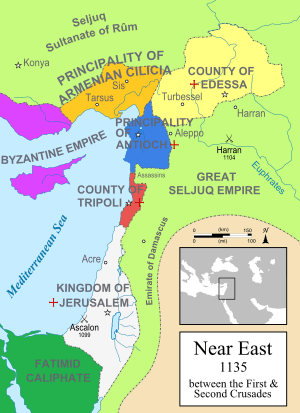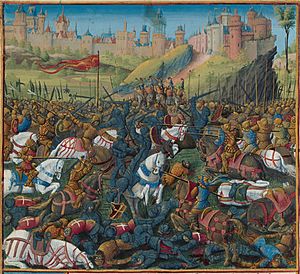Constance of Antioch facts for kids
Quick facts for kids Constance |
|
|---|---|
| Princess of Antioch together with Raymond (1136–1149) and Raynald (1153–1160 or 1161) |
|
| Reign | 1130 – 1163 |
| Predecessor | Bohemond II |
| Successor | Bohemond III |
| Regents |
See list
|
| Born | 1128 |
| Died | 1163 (aged 34–35) |
| Spouse | Raymond of Poitiers Raynald of Châtillon |
| Issue | Bohemond III of Antioch Maria, Byzantine Empress Philippa, Lady of Toron Baldwin of Antioch Agnes, Queen of Hungary |
| House | Hauteville |
| Father | Bohemond II |
| Mother | Alice of Jerusalem |
| Religion | Catholicism |
Constance of Hauteville (born 1128, died 1163) was a powerful princess who ruled the Principality of Antioch from 1130 to 1163. She was the only child of Bohemond II of Antioch and his wife, Alice of Jerusalem.
Constance became princess when she was only two years old. Her father died in battle, leaving her as the ruler. Her mother, Alice, first tried to rule for her. But the noblemen of Antioch decided that Constance's grandfather, Baldwin II of Jerusalem, should be her regent (someone who rules for a child).
After Baldwin II died in 1131, Alice tried to take control again. However, the Antiochene nobles chose her brother-in-law, Fulk of Anjou, to be Constance's regent instead.
Constance married Raymond of Poitiers in 1136. Raymond then ruled Antioch while Constance had four children. After Raymond was killed in a battle in 1149, Fulk of Anjou's son, Baldwin III of Jerusalem, became regent. He wanted Constance to remarry, but she didn't like his choices. She also said no to marrying an older relative of the Byzantine Emperor Manuel I Komnenos.
Finally, Constance married Raynald of Châtillon, a knight from France, in 1153. Around 1160 or 1161, her second husband was captured. Constance wanted to rule Antioch by herself. But Baldwin III of Jerusalem declared her fifteen-year-old son, Bohemond III, the rightful prince. Constance ignored this and took control with help from Emperor Manuel. However, she was later removed from power in favor of her son, shortly before she died.
Contents
Early Life and Becoming Princess
A Young Ruler's Beginnings
Constance was born in 1128. She was the only child of Prince Bohemond II of Antioch and Alice, who was the daughter of King Baldwin II of Jerusalem. Constance was named after her grandmother, Constance of France.
In February 1130, Constance's father, Bohemond, was killed in a battle near the Ceyhan River. After his death, her mother, Alice, became the regent for Constance. This meant Alice would rule Antioch until Constance was old enough.
Some people in Antioch spread rumors that Alice planned to send Constance to a monastery. Others said Alice wanted to marry Constance to a common person. Bohemond's cousin, Roger II of Sicily, also claimed he should be the ruler of Antioch. He was the oldest living member of the House of Hauteville family.
Challenges to Her Mother's Rule
The noblemen of Antioch asked Baldwin II, Constance's grandfather, to come to Antioch. They wanted him to take over the regency from Alice. But Alice decided to go against her father.
A historian from the 12th century, William of Tyre, wrote that Alice even tried to get help from Imad ad-Din Zengi, a powerful ruler from Aleppo. William of Tyre said that Baldwin II's soldiers captured Alice's messengers. Baldwin II had already arrived in Antioch. Soon, Alice had to ask her father for forgiveness. He removed her from the regency and told her to leave Antioch.
Ruling Antioch
Childhood and Regents

The nobles of Antioch accepted Baldwin II as Constance's regent. They promised to be loyal to him and to Constance. Baldwin II chose Joscelin I, Count of Edessa, to be Constance's guardian. Joscelin would rule Antioch until Constance got married.
Baldwin II died on August 21, 1131. Joscelin I died just a week later.
Alice again tried to become regent. But most Antiochene lords did not want a woman to rule. They sent messengers to Baldwin II's successor, Fulk of Anjou. Fulk was Alice's brother-in-law. Alice then made an alliance with Joscelin II, Count of Edessa, and Pons, Count of Tripoli, in early 1132.
Fulk had to travel to Antioch by sea because Pons would not let him pass through his land. Fulk landed at St. Symeon. There, the Antiochene nobles recognized him as regent. He appointed Rainald I Masoir, the Constable of Antioch, to manage the principality.
Fulk returned to Antioch when Zengi sent an army to invade in 1132 or 1133. After defeating the invaders, Fulk entered Antioch. The principality needed a strong leader. So, the Antiochene nobles asked Fulk to choose a husband for Constance. He chose Raymond of Poitiers, a younger son of William IX, Duke of Aquitaine. Fulk kept his decision a secret. He wanted to stop Alice and Roger II of Sicily from interfering.
First Marriage and Family
Alice's sister, Melisende, who was Fulk's wife, convinced Fulk to let Alice return to Antioch in 1135. Alice wanted to make Antioch closer to the Byzantine Empire. She offered Constance's hand in marriage to Manuel, a son of the Byzantine Emperor John II Komnenos.
To stop this Byzantine marriage, Fulk sent a messenger to France. He urged Raymond of Poitiers to come to Antioch. Raymond traveled in disguise because Roger II of Sicily wanted to capture him.
Raymond of Poitiers arrived in Antioch in April 1136. Ralph of Domfront, a church leader, tricked Alice into thinking Raymond came to marry her. But Constance, who was eight years old, was taken from the palace. Ralph of Domfront then blessed her marriage to Raymond in the cathedral. With this marriage, Raymond became the ruler of Antioch. Alice then moved away to Lattakieh.
In early 1147, Roger II of Sicily offered to transport French crusaders to the Holy Land for the Second Crusade. But Louis VII of France and his wife, Eleanor of Aquitaine (who was Raymond of Poitiers' niece), said no. They worried Roger only wanted to claim Antioch. Louis and his crusaders came to Antioch in March 1148.
Challenges and a New Marriage
Raymond was killed in the Battle of Inab on June 29, 1149. This happened during a fight against Nur ad-Din Zangi. Constance and Raymond had four young children. There was no one to lead Antioch. Nur ad-Din invaded and took all Antiochene lands east of the Orontes River.
Aimery of Limoges, a church leader, led the defense. But most nobles wanted a secular ruler. Constance's cousin, Baldwin III of Jerusalem, quickly came to Antioch. He became regent and made a peace agreement with Nur ad-Din.
Baldwin III returned to Antioch in summer 1150. He wanted Constance to remarry. He suggested three men, but she refused them all. In early 1152, Constance went to Tripoli to meet Baldwin III and her two aunts, Melisende and Hodierna. They tried to convince her to choose a husband, but she returned to Antioch without promising anything.
Some historians believe that Patriarch Aimery encouraged Constance to resist. He wanted to control the government. The Byzantine Emperor Manuel I Komnenos sent his widowed brother-in-law, an older man, to Antioch to marry Constance. But she did not like him because of his age and refused to marry him.
Historian Steven Runciman suggests Constance might have refused these men because she had met Raynald of Châtillon. He was a knight from France. Even though some described Raynald as a "common knight," Constance decided to marry him. Their engagement was kept secret. Constance wanted to get Baldwin III's permission first.
Second Marriage and Later Years
After Baldwin approved the marriage, Constance and Raynald married in early 1153. Raynald took charge of ruling Antioch. But he was not popular because people saw him as an outsider. He often tried to raise money, which caused problems with Patriarch Aimery and Emperor Manuel I. The emperor forced Raynald to show respect to him in 1159.
In November 1160 or 1161, Raynald was captured and imprisoned by Majd al-Din, a governor from Aleppo.
After her husband was captured, Constance said she wanted to rule Antioch. But most Antiochene nobles preferred a male ruler. Baldwin III of Jerusalem quickly came to Antioch. He declared Constance's fifteen-year-old son, Bohemond III, the rightful prince. He put Patriarch Aimery in charge of running Antioch.
Constance did not accept Baldwin's decision. She complained to Emperor Manuel. Manuel sent his nephew and another official to Antioch. They started talks about Manuel marrying Constance's daughter, Maria. The marriage agreement was signed. The emperor's representatives confirmed Constance's position as the ruler of Antioch. Baldwin III, who came to Antioch to meet the emperor's envoys, did not object.
Constance's son, Bohemond, became an adult in 1163. To make her position stronger against her son, Constance asked for help from a Byzantine governor. However, the Antiochene nobles teamed up with Thoros II of Cilician Armenia. They forced Constance to leave Antioch. After Constance was removed, Bohemond III took control. Constance died soon after, likely in Lattakieh or Byblos.
Family
Constance's first husband, Raymond of Poitiers, was born in 1114. He was the second son of William IX, Duke of Aquitaine. When Raymond died in 1149, Constance had "two sons and as many daughters still underage." Their older son, Bohemond, was five years old when his father died. He took control of Antioch from his mother in 1163.
Constance and Raymond's daughter, Maria, was known for her beauty. She married the Byzantine Emperor Manuel I Komnenos in 1161. Another daughter, Philippa, married Humphrey II of Toron in the late 1160s.
It is not certain if Constance's second son, Baldwin, was Raymond's child or Raynald's. Baldwin died fighting in a Byzantine army in the Battle of Myriokephalon on September 17, 1176. It is known that Raynald was the father of Agnes. Agnes later married Béla III of Hungary. Raynald and Constance's second daughter, Alice, became the third wife of Azzo VI of Este in 1204.
See also
 In Spanish: Constanza de Antioquía para niños
In Spanish: Constanza de Antioquía para niños


